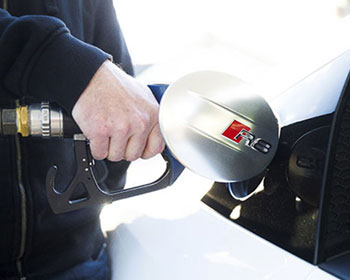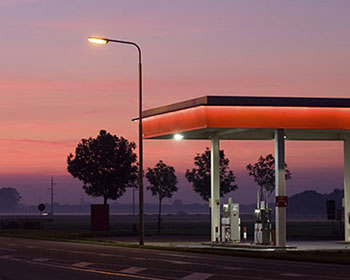How Clean Is Your Fuel?

Bridgestone Australia
You'd Be Surprised
12 December, 2017
How does fuel quality vary around the world – petrol and diesel – and who has the best fuel, who has the worst, and why?
There’s plenty of oil out there but the process to change it from thick black crud to refined unleaded petrol is as laborious as it is expensive. An intensive scientific process, the process of refining oil varies around the world depending on the destination market, resulting in drastically varying qualities of fuel over the world.
Clean unleaded petrol ideally has a low amount of sulphur and less than 1mg/L of sediment (dirt). It’s near impossible to remove all contaminants so there’s always a bit found in any fuel. In addition to cleaning the fuel, a detergent is added. Detergent is in all unleaded petrol and diesel fuels - it helps clean things in the engine like the valves, injectors and internal combustion chambers. It also has the added benefit of lowering emissions.
The benefits of detergent mean a great deal to manufacturers because it can help an engine remain in good condition (which prevents warranty repairs) while lowering emissions. However, for a long time, there was no mandatory requirement of just how clean fuel should be and how much detergent it could contain. As a result, in the 1980s when fuel injection started to hit the scene, it wasn’t uncommon for the fuel in circulation to block fuel injectors!
More recently however, car manufacturers in the US rallied together to create a regulated fuel called ‘Top Tier’. Top Tier promises a minimum of two to three times the detergents than in fuel from ‘regular’ outlets. In testing, it provides visibly better engine care and lower emissions. There’s also the World Fuel Charter that dictates all unleaded fuel should have less than 1mg/L of sediment and less than 30g/KG of sulphur.
There’s plenty of oil out there but the process to change it from thick black crud to refined unleaded petrol is as laborious as it is expensive. An intensive scientific process, the process of refining oil varies around the world depending on the destination market, resulting in drastically varying qualities of fuel over the world.
Clean unleaded petrol ideally has a low amount of sulphur and less than 1mg/L of sediment (dirt). It’s near impossible to remove all contaminants so there’s always a bit found in any fuel. In addition to cleaning the fuel, a detergent is added. Detergent is in all unleaded petrol and diesel fuels - it helps clean things in the engine like the valves, injectors and internal combustion chambers. It also has the added benefit of lowering emissions.
The benefits of detergent mean a great deal to manufacturers because it can help an engine remain in good condition (which prevents warranty repairs) while lowering emissions. However, for a long time, there was no mandatory requirement of just how clean fuel should be and how much detergent it could contain. As a result, in the 1980s when fuel injection started to hit the scene, it wasn’t uncommon for the fuel in circulation to block fuel injectors!
More recently however, car manufacturers in the US rallied together to create a regulated fuel called ‘Top Tier’. Top Tier promises a minimum of two to three times the detergents than in fuel from ‘regular’ outlets. In testing, it provides visibly better engine care and lower emissions. There’s also the World Fuel Charter that dictates all unleaded fuel should have less than 1mg/L of sediment and less than 30g/KG of sulphur.
This all sounds good, but even Down Under, things aren’t perfect. In Australia, our fuel contains around 150ppm sulphur which compares poorly to Japan, South Korea, Europe and the US where fuel contains 10ppm. Our fuel also contains a greater amount of aromatics which make it smell sweet and improve the octane rating, but also mean it’s dirtier. There’s also very little regulation or clarity around detergents in any given fuel.
So, Australia is about middle of the road when it comes to fuel quality and pales in comparison to the US, Europe and some Asian countries. But who has the worst fuel?
Some of the larger refineries in Europe export fuel to Africa, and samples taken in Togo, Ghana, and Cote d'Ivoire showed sulphur levels of over 3,000ppm, or 300 times that of Europe. Of course this fuel was far cheaper to make, and because Africa was an unregulated country, the exporters could effectively get away with it.
Things are changing though and better fuel standards are being set worldwide. In Africa, ultra-low-sulphur diesel is beginning to be offered and regulations have been brought forward to ensure all fuels imported have a maximum sulphur level of 50ppm - less than that of Australia.
Got an opinion on fuel quality? We’d love to hear from you, share it in the comments below or join the conversation on Facebook.
So, Australia is about middle of the road when it comes to fuel quality and pales in comparison to the US, Europe and some Asian countries. But who has the worst fuel?
Some of the larger refineries in Europe export fuel to Africa, and samples taken in Togo, Ghana, and Cote d'Ivoire showed sulphur levels of over 3,000ppm, or 300 times that of Europe. Of course this fuel was far cheaper to make, and because Africa was an unregulated country, the exporters could effectively get away with it.
Things are changing though and better fuel standards are being set worldwide. In Africa, ultra-low-sulphur diesel is beginning to be offered and regulations have been brought forward to ensure all fuels imported have a maximum sulphur level of 50ppm - less than that of Australia.
Got an opinion on fuel quality? We’d love to hear from you, share it in the comments below or join the conversation on Facebook.

The process of refining oil varies around the world depending on the destination market, resulting in drastically varying qualities of fuel over the world.

